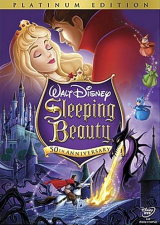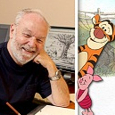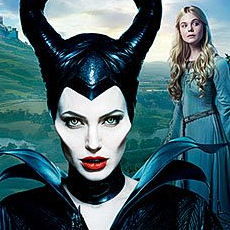Princess Aurora has been cast, but Sleeping Beauty will need a villain. Who better to turn to than legendary Disney animator Marc Davis, and in Chapter Two of our celebrating the release of Walt Disney’s 1959 animated classic on DVD and Blu-ray, Burny Mattinson remembers working with the man himself.
 With the inevitable passing of all the Nine Old Men, there are now only a few remaining Disney artists that can say they worked directly with Walt Disney on any his animated classics. So, it’s always a very special experience to be able to talk with one of them.
With the inevitable passing of all the Nine Old Men, there are now only a few remaining Disney artists that can say they worked directly with Walt Disney on any his animated classics. So, it’s always a very special experience to be able to talk with one of them.
Following the release of Sleeping Beauty on Platinum Edition DVD and Blu-ray, we were privileged to join a roundtable discussion organized by Walt Disney Studios Home Entertainment to talk with Disney Legend Burny Mattinson about his collaboration with Marc Davis on Maleficent, the film’s iconic villainess.
Burny Mattinson was born in San Francisco and still recalls the profound impact that seeing Pinocchio had on him at the age of six. By the time he was twelve, he was drawing Disney-type characters and dreaming of being a cartoonist. He started his career at Disney in 1953 working in the studio mail room. He was eighteen and had no formal art training, but within six months, he was delivering more than mail as he ascended the rungs of the animation ladder, beginning as an in-betweener on Lady and the Tramp. He was promoted to assistant animator on Sleeping Beauty and continued in that capacity on 101 Dalmatians. He spent the next twelve years assisting Eric Larson on such films as The Sword in the Stone, The Jungle Book and The AristoCats.
In 1972, after completing an internal training program, he became an animator on Robin Hood and a key animator on Winnie the Pooh and Tigger Too. Following this, he worked on storyboards and title designs for The Rescuers and The Fox and the Hound, before directing the Oscar-nominated Mickey’s Christmas Carol in 1983. The following year, Burny co-wrote, produced and directed on The Great Mouse Detective alongside John Musker and Ron Clements.
He served as a key member of the story team on Disney’s contemporary classics including Aladdin, Beauty and the Beast, The Lion King, Pocahontas, Mulan, The Hunchback of Notre Dame, Tarzan, and most recently the highly successful Goofy short How to Hook Up Your Home Theater. As Disney prepares a return to the kinds of features that their legacy was built upon, Burny continues to develop a number of future projects with Walt Disney Animation Studios.

Roundtable Interviewer: Could you tell us what your contribution to the movie – and to the Maleficent character in particular – was?
Burny Mattinson: I was Marc Davis’ assistant and did the follow-up work on each scene. Actually the clean-up work was done by a whole unit of assistant animators. Dale Barnhart and Art Stevens where part of this unit who were both animators. I did the rough animation work behind Marc.
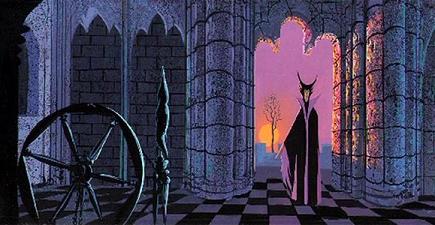
RI: With this movie, Walt Disney wanted to change the rounded, softer look of his earlier movies to a look that was much more stylized. I read that the backgrounds were inspired on early Renaissance paintings and that the characters were designed to blend with these settings. Was it difficult to adapt to this new style?
BM: Yes! It was a learning curve for all of us to design the characters to fit Eyvind Earle’s backgrounds [below] and it took us much longer to do the animation because of it. Within the Gothic painting style as Eyvind interpreted it, he used very strong horizontals and verticals in the backgrounds so our characters had to have the straights and curves to fit these backgrounds. It was highly stylized for us to work within.
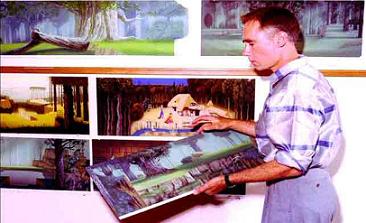
RI: What is the most difficult aspect in creating a character?
BM: Certainly finding what they ‘want’ – you need to know what they ‘want’ as a character. Design is a big factor in designing a villain which makes them stand apart from the other good characters…the fact that things are sharp or edged in the design – the colors reflect her evil qualities. A voice has a lot to do with it because you can hear what’s in her soul and that helps a lot. But, it’s a combination of all these factors.
RI: What is the usual time frame for creating a villain, in this case Maleficent?
BM: It actually starts with the concept of the story and through the course of development, she becomes more and more focused and her character becomes more clarified. In this case it took approximately four years from concept of story to finished film. In actual animation it was approximately 18 months.
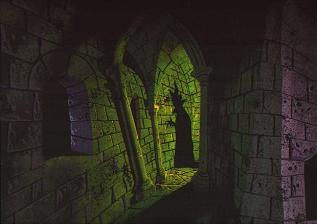
RI: The film was in development for a lot of years. Were there any ideas that were worked on in those years that you wished had made the finished film?
BM: No, I really wasn’t in the development stage of the picture – I was only involved in the actual animation stage of production.
RI: What were the main challenges the team at Disney faced to ensure they had a unique villain character?
BM: A lot of it was in the writing and the fact that Maleficent was different in size and shape than the good fairies. She was more angular and her whole manner and voice contributed to her evil qualities. The headdress was striking and the color of her face and the fact that she was dressed mainly in black and purple – dark evil colors. The three fairies were very loose and fluid and Maleficent was very controlled. All of these factors contributed to her being a memorable villain.
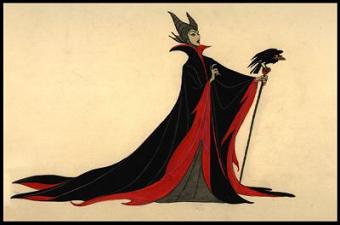
RI: When I look at the villains in Disney movies I notice that a lot of the villains have a lot of purple in their color palette either skin, hair or costume color. This is especially true in the older Disney movies: I’m thinking of villains like the Queen in Snow White, the evil stepmother of Cinderella, Maleficent, Captain Hook, Madam Mim, Ursula… Studies show that people associate the color purple with envy, arrogance and flamboyance (among other associations); is it a coincidence that these villains, where envy is an important part of their evilness, have a purple color palette? Or is it just a typical feminine color which just looks more evil than pink? Or does it have a commercial reason since I once read that comics in the Silver Age sold better when they had the color purple on the cover.
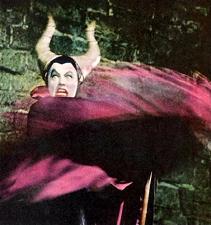 BM: Maleficent was never conceived with the color purple in the beginning. It was actually Eyvind Earle’s decision to change the color red to purple in her garments to fit into his background palettes. There’s a lot of green in Eyvind’s backgrounds – especially in the forest and the castle, and as purple is the opposite of green it’s a complementary color which is the best choice to work with. But, the reasons for the heavy use of purple in other characters – Ursula, for example, she’s in the greenish-bluish sea – the purple was again a complementary color choice. But, overall, purple is just a great color.
BM: Maleficent was never conceived with the color purple in the beginning. It was actually Eyvind Earle’s decision to change the color red to purple in her garments to fit into his background palettes. There’s a lot of green in Eyvind’s backgrounds – especially in the forest and the castle, and as purple is the opposite of green it’s a complementary color which is the best choice to work with. But, the reasons for the heavy use of purple in other characters – Ursula, for example, she’s in the greenish-bluish sea – the purple was again a complementary color choice. But, overall, purple is just a great color.
RI: Do you base your characters on people you know or do they come from your imagination?
BM: When we’re animating, we try to create them from real people when we can. You try to add imagination to them as best you can, but it varies per story and character. Again, the voice of Maleficent was tremendously influenced by Eleanor Audley and a lot of the choices that Marc made came from all his vast experiences – he always talked about observing people and remembering mannerisms of people.
RI: Some characters’ movements, like Aurora’s, were based on live action choreography. How was this done for Maleficent?
BM: Eleanor Audley did some live-action reference work on certain scenes, but there was very little reference work for Maleficent because Marc generally kept her still so her movement was limited because she was always in a controlled, confined space.
RI: In what way were you influenced by the voice of Eleanor Audley? And by her filmed performance?
BM: Eleanor Audley influenced us tremendously – she did the same type of controlled voice presentation as she did in Cinderella, which was slow and deliberate, and she was able to reflect her character’s evilness in the tones of her voice. She was a natural in that respect.
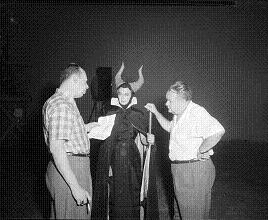
RI: Had Walt any input in the treatment of Maleficent or was it all Marc Davis’ vision? How were their working relationship on that character?
BM: I think Marc certainly checked with Walt quite often on designs and approach on how to do the character, but the majority of the responsibility of the character was Marc shoulders and Walt trusted Marc implicitly. They had regular ‘sweatbox’ sessions in which Walt would view the rough footage and then give comments to Marc if there was something that needed change. In essence, Walt was always the director of the movie, but he would give direction to his animators in the sweatbox if he had an idea on how to handle something better. Walt would act out how he saw the different characters in story sessions to convey the feeling and mood that Walt wanted to see the animators execute within the scenes.

RI: If you had been in charge of designing Maleficent at the time, what would you have done differently?
BM: Nothing – I don’t think I could have come up with as good a design as Marc. It was a perfect design and he explored all the possibilities. Marc had a lot of help with folks from the story department, but he certainly hit it right on the head with Maleficent.
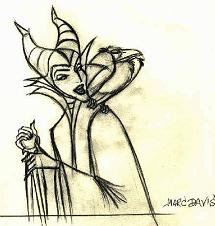 RI: It seems that the part of Maleficent is more dialogue oriented than action oriented. How did you deal with that aspect of the character as an animator?
RI: It seems that the part of Maleficent is more dialogue oriented than action oriented. How did you deal with that aspect of the character as an animator?
BM: We purposely kept her controlled and quiet and we let her dialogue do her acting for us. The reason for this was that we wanted to use those moments of when she exploded as accents that would frighten the audience. We kept her sweet, nice and controlled and then let her blow up on purpose.
RI: In your bio, you say “less is more” in animation. How did you apply that with Maleficent?
BM: By the very fact that she moved very little – this was a stronger message than if we had her moving all around and being overly dramatic. We kept her movements confined purposely to give her a strong, evil, controlled state.
RI: How did you conceive, animation-wise, the relationship between Maleficent and her pet crow?
BM: The reason for having the raven was to give Maleficent somebody to talk to – otherwise, she’d just be standing there giving speeches into the air – she would have had nothing to work against. Later, we found the raven was a great device to go out and do her bidding – finding Briar Rose, when the goons had failed. The raven, also was a sycophant to her.

RI: Was there ever any talk of making Maleficent’s raven Diablo a speaking character?
BM: No – there was never any consideration of this that I’m aware of.
RI: How did you achieve the animating of her large cape? Did you reference films or photos to help you animate the movement of that huge cloth? Was it difficult?
BM: No – again, Marc was able to do it effortlessly. Mainly, he tried to fill the screen with Maleficent’s cape to give her visual and dramatic impact. The interior of her cape, and the color purple, gave a strong visual effect of flames.
RI: Were there ever any concerns about Maleficent becoming too scary?
BM: I don’t believe we had any concerns about her being too scary – Marc was certainly in control of her as far as her acting… I think with his good taste and his understanding of the character he brought it off beautifully! You want a villain as bad as possible, but you also want to present them in a tasteful manner.

RI: What fictional villains frightened you as a child?
BM: Frankenstein! I remember sitting in the theater and thinking he was coming down the aisle behind me. The other one was The Thing!
 RI: Maleficent and the three Good Fairies are very much the driving forces of the story. Were there any worries during production that this would make the main human characters too passive?
RI: Maleficent and the three Good Fairies are very much the driving forces of the story. Were there any worries during production that this would make the main human characters too passive?
BM: No, I think we felt the human characters were ‘acted upon’ – in other words, they needed to be passive. Except the Prince did take control at the very end, becoming more aggressive. No, we weren’t worried about that since the fairies and Maleficent were driving the story, the ‘human’ characters were being ‘acted upon.’
RI: How did the wider aspect ratio of the film influence the day to day workflow compared to the workflow of many of the standard ratio movies before then?
BM: It caused a lot of problems, due to the fact that instead of working with 16″ paper, we were working with 48″ paper lengths – it slowed us down considerably. More mileage background-wise and character-wise meant more space to move a character across the screen. We had to put everything on a single frame which meant more drawings. Everything was twice as time-consuming.
RI: Which scene, in your opinion, benefits most from the wide 70mm Technirama canvas?
BM: It’s hard to say because the whole experience of the picture plays well in this format. The beauty of Eyvind Earle’s backgrounds spread out in 70mm is spectacular. The forest sequence always played well. Wait ’til you see the Blu-ray on this – it plays out beautifully!
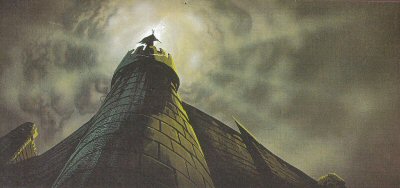
RI: How do you feel about this being the first ‘classic’ Disney film released on a high-definition format?
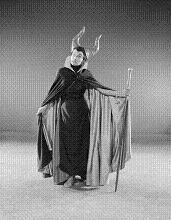 BM: I feel excited – it’s wonderful! I’m looking forward to all of the classic Disney animated films being on Blu-ray and Sleeping Beauty is probably one of the best to go first. We truly tried to make it a work of art when we did it, and now after seeing it in Blu-ray, I find myself enjoying it more than I ever did before. Now audiences will get to see it in Blu-ray and it’s an enchanting experience!
BM: I feel excited – it’s wonderful! I’m looking forward to all of the classic Disney animated films being on Blu-ray and Sleeping Beauty is probably one of the best to go first. We truly tried to make it a work of art when we did it, and now after seeing it in Blu-ray, I find myself enjoying it more than I ever did before. Now audiences will get to see it in Blu-ray and it’s an enchanting experience!
RI: What is the real improvement about the image and sound of this Platinum Edition over the previous DVD?
BM: The most spectacular difference in the image is the Blu-ray process. Now being able to see Sleeping Beauty in such clarity and sharpness, and the fact that it’s all been beautifully restored, it’s a spectacular difference from past releases. Sound-wise, again, there’s a clarity in the sound that has been restored that we’ve never had. In other words, all new technology has made it bigger and better and more wonderful.
RI: Do you think the change to CGI has been a good one – or do you share the view that some of the charm of the older ‘classic’ Disney films has been lost now that they are made much more quickly?
BM: I don’t think there’s a difference in the time spent making a CG or hand-drawn film, it’s about the same length to make, as we spend a tremendous amount of time in story development. I think the method of animation in which a story is told is not the important factor, it’s just a creative choice in how you want to tell the story. The story itself is the most important part of it – that’s why we spend such a long time in story development.
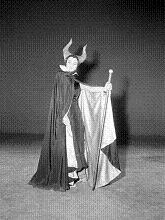 RI: Sleeping Beauty was very influential for young animators. What was influential for you?
RI: Sleeping Beauty was very influential for young animators. What was influential for you?
BM: Working with Marc Davis and learning the craft through him. Certainly, Pinocchio was the film that influenced me and why I wanted to get into the business. Every film I worked on was a learning curve – Lady and the Tramp and then Sleeping Beauty…all the films I worked with the Nine Old Men on were such an experience because they had so much to offer. There was such a wealth of information on the art of animation that you were learning from them.
RI: What was the most important thing you’ve learned from Marc Davis [below]?
BM: He had a professionalism that was so wonderful! I tried to let it rub off on me. He was very calm and I think there’s a side of Marc that I’ve always loved which was his little chortle – it was so endearing and made him fun to be around. Regarding animation, one of the things he told me was ‘Animation was 75% thinking and 25% execution’ and I’ve always used that bit of advice throughout my years in animation.
RI: What’s your favorite scene from Sleeping Beauty?
BM: Scene 31, sequence 8, which was the first scene to be made in the picture. It was 43 feet long and the first scene in which Aurora is in the forest singing ‘I wonder, I wonder’ picking berries and singing with the birds. It’s memorable to me because it’s the first scene done to see if the animation would work with Eyvind’s backgrounds and it was critical to Walt to see if this approach would work…and the fact that I had to redo it so many times. Marc took me to a local restaurant and gave me a cake saying ‘Happy 31’ when Walt okayed it for final color!
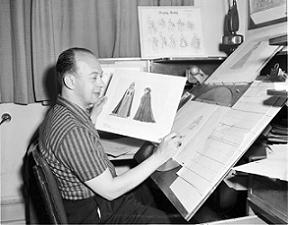
RI: Maleficent is one of Disney’s darkest villains. Have the villains changed much over time, and which ones do you prefer working on?
BM: I prefer working on all the villains – they’re the most interesting of the animated characters. I don’t think the villains have changed much. They all have an agenda of their own that has driven their greed or has made them evil. They all have their own different styles of delivery and how they react, but basically they all have evil intent.
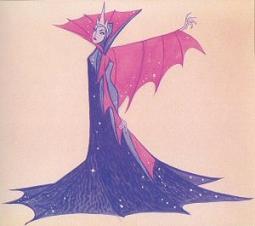
RI: Fifty years on, do you look at Maleficent differently from when you were animating her?
BM: Actually, I probably like her more now than I did then – I think she is a much better villain now than at the time. Sometimes you get so close to these pictures as you’re concentrating on the work, you don’t think about the characters so much, but, I think she’s a real stinker of a villain – which makes for a good villain!
RI: Why do you think she still stands up as a memorable Disney villain even after five decades?
BM: This picture has become a classic and within this great picture Maleficent is such a strong villain. A classic stands out over time.

Our thanks go to Mac McLean and Mindy Johnson.


